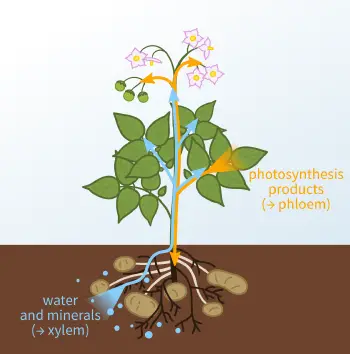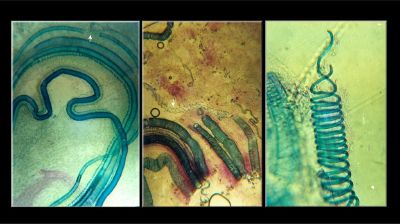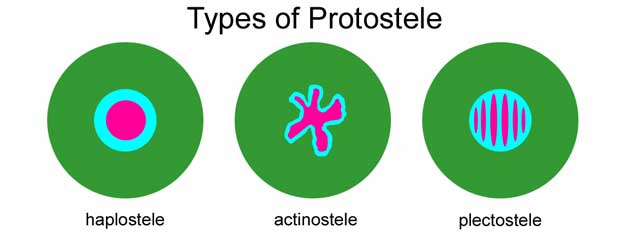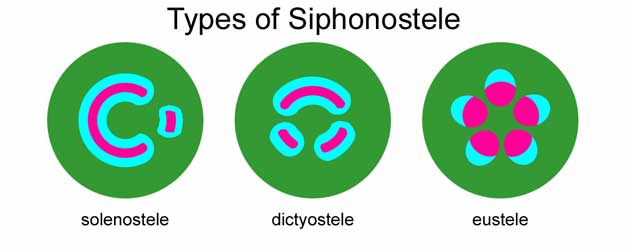Xylem
In vascular plants, xylem is one of the two types of transport tissue; phloem is the other vascular tissue. Xylem is the primary water-conducting tissue and phloem circulates a nutrient-rich sap throughout the plant.
The term âxylemâ is derived from classical Greek xĂșlon, "wood," and indeed the best known xylem tissue is wood. Xylem conducts water and dissolved minerals from the root up the plant into the shoots.
The vascular system of xylem and phloem tissue reflects a unity and harmony of creation. The xylem moves water and minerals from the soil, through the roots, to other parts of the plant, including the leaves. The phloem transports sugars, produced in the leaves, to the diverse parts of the plant, including the roots. An analogy is often drawn between this network (xylem and phloem) and the harmony of the blood vessels (veins and arteries) of the human body, with both systems transporting essential fluids to and from parts of the organism.
Xylem can be found:
- in vascular bundles, present in non-woody plants and non-woody plant parts.
- in secondary xylem, laid down by a meristem called the vascular cambium. A meristem is a tissue in plants consisting of undifferentiated cells (meristematic cells) and found in zones of the plant where growth can take placeâroots and shoots.
- as part of a stelar arrangement not divided into bundles, as in many ferns.
Structure
The most distinctive cells found in xylem are those that conduct water, the tracheary elements: tracheids and vessel elements. Both are elongated cells that are dead; the living material in the interior disintegrates, leaving behind thickened cell walls through which xylem sap flows. (Sap usually refers to a watery fluid with dissolved substances that travels through vascular tissues, whether involving the xylem or the phloem.)
In most plants, pitted tracheids function as the primary transport cells. Vessel elements transport water in angiosperms. Xylem also contains other kinds of cells in addition to those that serve to transport water.
Tracheid
A tracheid conducts water and gives support to the xylem. Tracheids are long, narrow cells with tapered ends whose walls are hardened with lignin, a chemical compound that fills in spaces in the cell wall. The lignin thickens the wall, making it strong and able to provide support as well as function in water transport. There are spaces along the cell wall where the secondary walls, hardened with lignin, are absent. Here, there are only the thin primary walls. These regions where only primary walls are present are called pits. Water passes from cell to cell through the pits.
Vessel element
Vessel elements are the building blocks of vessels, which constitute the major part of the water-transport system in the plants where they occur. They are elongated, but generally shorter and wider than tracheids. As with tracheids, the cell wall of vessel elements is strongly lignified. At both ends, there are openings that connect the individual vessel elements. These are called perforations or perforation plates, and they allow water to flow easily through the xylem vessel. These perforations have a variety of shapes: the most common are the simple perforation (a simple opening) and the scalariform perforation (several elongated openings on top of each other in a ladder-like design). Other types include the foraminate perforation plate (several round openings) and reticulate perforation plate (net-like pattern, with many openings). The side walls will have pits, and may have spiral thickenings.
Vessel elements are typically found in the angiosperms; their absence from the conifers is noteworthy.
Function
Two forces cause xylem sap to flow:
- The soil solution (see soil) is more dilute than the cytosol of the root cells. Thus, water moves osmotically into the cells, creating root pressure. Root pressure is highly variable between different plants. For example, in Vitis riparia pressure is 145 kPa, but it is near zero in Celastrus orbiculatus (Tibbetts and Ewers 2000).
- The main phenomenon driving the flow of xylem sap is transpirational pull. The reverse of root pressure, this is caused by transpiration, the loss of water by evaporation. In larger plants such as trees, the root pressure and transpirational pull work together as a pump that pulls xylem sap from the soil up to where it is transpired.
Location
Xylem is present in vascular bundles, secondary xylem, and stelar arrangements.
Vascular bundle
A vascular bundle is a strand of vascular tissue that runs the length of a stem. Both xylem and phloem tissues are present in a vascular bundle, which also has supporting and protective tissues.
The xylem typically lies adaxial (towards the axis or central line) with phloem positioned abaxial (away from the axis or central line). In a stem or root, where vascular bundles are cylindrical, this means that the xylem is closer to the center of the stem or root while the phloem is closer to the exterior, in the bark area. In a leaf, the adaxial surface of the leaf will usually be the upper side, with the abaxial surface the lower side. Aphids are typically found on the underside of a leaf rather than on the top, since the sugars manufactured by the plant are transported by the phloem, which is closer to the lower surface.
Usually a vascular bundle will contain primary xylem only.
The position of vascular bundles relative to each other may vary considerably.
Secondary xylem
The girth, or diameter, of stems and roots increases by secondary growth, which occurs in all gymnosperms, and most dicot species among angiosperms. Secondary xylem is laid down by the vascular cambium, a continuous cylinder of meristematic cells that forms the secondary vascular tissue.
The vascular cambium forms in a layer between the primary xylem and primary phloem, giving rise to secondary xylem on the inside and secondary phloem on the outside. Every time a cambium cell divides, one daughter cell remains a cambium cell while the other differentiates into either a phloem or a xylem cell. Cambium cells give rise to secondary xylem to the outside of the established layer(s) of xylem during secondary growth.
A cross section of a stem after secondary growth would show concentric circles of pith (the center), primary xylem, secondary xylem, vascular cambium, secondary phloem, primary phloem, cork cambium, cork, and periderm (the outermost layer). Bark consists of tissues exterior to the vascular cambium.
The tree's diameter increases as layers of xylem are added, producing wood. The secondary phloem eventually dies, protecting the stem until it is sloughed off as part of the bark during later growth seasons.
The two main groups in which secondary xylem can be found are:
- conifers (Coniferae): there are some six hundred species of conifers. All species have secondary xylem, which is relatively uniform in structure throughout this group. Many conifers become tall trees: the secondary xylem of such trees is marketed as softwood.
- angiosperms (Angiospermae): there are some quarter of a million to 400,000 species of angiosperms. Within this group, secondary xylem has not been found in the monocots. In the remainder of the angiosperms, secondary xylem may or may not be present; this may vary even within a species, depending on growing circumstances. Many non-monocot angiosperms become trees, and the secondary xylem of these is marketed as hardwood.
Secondary xylem is also found in members of the "gymnosperm" groups Gnetophyta and Ginkgophyta and to a lesser extent in members of the Cycadophyta.
Stele
Xylem can also be found in stelar arrangements. In a vascular plant, the stele is the central part of the root or stem containing the vascular tissue and occasionally a pith.
Protosteles
The earliest vascular plants are considered to have had both root and shoot with a central core of vascular tissue. They consisted of xylem in the center, surrounded by a region of phloem tissue. Around these tissues there might be an endodermis that regulated the flow of water into and out of the vascular core. Such an arrangement is termed a protostele.
There are three basic types of protostele:
- haplosteleâthe most basic of protosteles, with a cylindrical core of vascular tissue. This type of stele is the most common in roots.
- actinosteleâa variation of the protostele in which the core is lobed. This type of stele is rare among living plants, but is found in stems of the whisk fern, Psilotum.
- plectosteleâa protostele in which interconnected plate-like regions of xylem are surrounded and immersed in phloem tissue. Many modern club mosses (Lycopodiopsida) have this type of stele within their stems.
Siphonostele
Plants that produce complex leaves also produce more complex stelar arrangements. The hormones produced by the young leaf and its associated axillary bud affect the development of tissues within the stele. These plants have a pith in the center of their stems, surrounded by a cylinder containing the vascular tissue. This stelar arrangement is termed a siphonostele.
There are three basic types of siphonostele:
- solenosteleâthe most basic of siphonosteles, with a central core of pith enclosed in a cylinder of vascular tissue. This type of stele is found only in fern stems today.
- dictyosteleâa variation of the solenostele caused by dense leaf production. The closely arranged leaves create multiple gaps in the stelar core. Among living plants, this type of stele is found only in the stems of ferns.
- eusteleâthe most common stelar arrangement in stems of living plants. Here, the vascular tissue in arranged in vascular bundles, usually in one or two rings around the central pith. In addition to being found in stems, the eustele appears in the roots of monocot flowering plants.
Siphonosteles may be ectophloic, with the phloem tissue positioned on one side of the xylem and closer to the epidermis. They may also be amphiphloic, with the phloem tissue on both sides of the xylem. Among living plants, many ferns and some Asterid flowering plants have an amphiphloic stele.
There is also a variant on the eustele found in monocots like maize and rye. The variation has numerous scattered bundles in the stem and is called an atactostele. However, it is really just a variant of the eustele.
Evolution
Xylem appeared early in the history of terrestrial plant life. Fossil plants with anatomically preserved xylem are known from the Silurian (more than four hundred million years ago), and trace fossils resembling individual xylem cells may be found in earlier Ordovician rocks. The earliest true and recognizable xylem consists of tracheids with a helical-annular reinforcing layer added to the cell wall. This is the only type of xylem found in the earliest vascular plants, and this type of cell continues to be found in the protoxylem (first-formed xylem) of all living groups of plants. Several groups of plants later developed pitted tracheid cells, apparently through convergent evolution. In living plants, pitted tracheids do not appear in development until the maturation of the metaxylem (following the protoxylem).
The presence of vessels in xylem has been considered to be one of the key innovations that led to the success of the angiosperms. However, the occurrence of vessel elements is not restricted to angiosperms, and they are absent in some archaic or "basal" lineages of the angiosperms: (e.g., Amborellaceae, Tetracentraceae, Trochodendraceae, and Winteraceae), and their secondary xylem is described as "primitively vesselless" (Cronquist 1988). Whether the absence of vessels in basal angiosperms is a primitive condition is contested, the alternative hypothesis being that vessel elements originated in a precursor to the angiosperms and were subsequently lost (Muhammad 1982; Carlquist 2002).
Maple syrup
Although in vascular plants, the xylem is the principal water transporting medium and the phloem the main pathway of sugar transport, at times sugars do move in the xylem. An example of this maple sap, used to produce maple syrup. In late winter/early spring, producers of maple syrup tap trees and collect a sugary solution from the xylem, derived from carbohydrates stored in the stem.
This collection can be done from several species of trees, but the most popular is Acer saccharum, the "sugar maple" or "hard maple." During cold nights, the hydrolysis of starch reserves in the xylem parenchyma cells produces sugars that are transported in the xylem during warm days, forced up the trunk by expanding carbon dioxide (CO2).
ReferencesISBN links support NWE through referral fees
- Campbell, N. A., and J. B. Reece. 2002. Biology (6th ed.). San Francisco, CA: Benjamin Cummings. ISBN 0805366245
- Carlquist, S., and E. L. Schneider. 2002. âThe tracheidâvessel element transition in angiosperms involves multiple independent features: cladistic consequences.â American Journal of Botany 89: 185-195.
- Cronquist, A. 1988. The Evolution and Classification of Flowering Plant. New York, New York: The New York Botanical Garden. ISBN 0893273325
- Gifford, E. M., and A. S. Foster. 1988. Morphology and Evolution of Vascular Plants. (3rd ed.). New York: W. H. Freeman and Company. ISBN 0716719460
- Kenrick, P., and P. R. Crane. 1997. The Origin and Early Diversification of Land Plants: A Cladistic Study. Washington, D. C.: Smithsonian Institution Press. ISBN 1560987308
- Niklas, K. J. 1997. The Evolutionary Biology of Plants. Chicago and London: The University of Chicago Press. ISBN 0226580822
- Tibbetts, T. J., and F. W. Ewers. 2000. âRoot pressure and specific conductivity in temperate lianas: exotic Celastrus orbiculatus (Celastraceae) vs. native Vitis riparia (Vitaceae).â American Journal of Botany 87: 1272-78.
- Wilson, K., and D. J. B. White. 1986. The Anatomy of Wood: its Diversity and variability. London: Stobart & Son Ltd. ISBN 0854420347
- Muhammad, A. F. and R. Sattler. 1982. Vessel Structure of Gnetum and the Origin of Angiosperms. American Journal of Botany 69: 1004-1021.
External links
All links retrieved April 8, 2025.
- A Detailed Overview of Xylem BYJU'S
- Understanding the root xylem plasticity for designing resilient crops National Library of Medicine
- Xylem and phloem Basic Biology
- Xylem in Plants: Definition and Cell Types | Complex Tissue Biology Discussion
Credits
New World Encyclopedia writers and editors rewrote and completed the Wikipedia article in accordance with New World Encyclopedia standards. This article abides by terms of the Creative Commons CC-by-sa 3.0 License (CC-by-sa), which may be used and disseminated with proper attribution. Credit is due under the terms of this license that can reference both the New World Encyclopedia contributors and the selfless volunteer contributors of the Wikimedia Foundation. To cite this article click here for a list of acceptable citing formats.The history of earlier contributions by wikipedians is accessible to researchers here:
- Xylem history
- Vascular_bundle history
- Secondary_xylem history
- Stele_(biology)Â history
- Vessel_element history
- meristem history
The history of this article since it was imported to New World Encyclopedia:
Note: Some restrictions may apply to use of individual images which are separately licensed.



